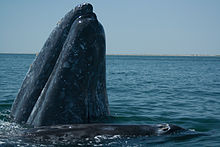Eschrichtius
| Gray whale Temporal range: Upper – Recent |
|
|---|---|
 |
|
| Gray whale spy-hopping next to calf | |
 |
|
| Size compared to an average human | |
| Scientific classification | |
| Kingdom: | Animalia |
| Phylum: | Chordata |
| Class: | Mammalia |
| Order: | Artiodactyla |
| Infraorder: | Cetacea |
| Family: | Eschrichtiidae |
| Genus: |
Eschrichtius Gray, 1864 |
| Species: | E. robustus |
| Binomial name | |
|
Eschrichtius robustus Lilljeborg, 1861 |
|
 |
|
| Gray whale range | |
| Synonyms | |
|
|
The gray whale (Eschrichtius robustus), also known as the grey whale,gray back whale, Pacific gray whale, or California gray whale is a baleen whale that migrates between feeding and breeding grounds yearly. It reaches a length of 14.9 meters (49 ft), a weight of 36 tonnes (40 short tons), and lives between 55 and 70 years. The common name of the whale comes from the gray patches and white mottling on its dark skin. Gray whales were once called devil fish because of their fighting behavior when hunted. The gray whale is the sole living species in the genus Eschrichtius, which in turn is the sole living genus in the family Eschrichtiidae. This mammal descended from filter-feeding whales that appeared at the beginning of the Oligocene, over 30 million years ago.
The gray whale is distributed in an eastern North Pacific (North American) population and a critically endangered western North Pacific (Asian) population. North Atlantic populations were extirpated (perhaps by whaling) on the European coast before 500 AD and on the American coast around the late 17th to early 18th centuries. However, on May 8, 2010, a sighting of a gray whale was confirmed off the coast of Israel in the Mediterranean Sea, leading some scientists to think they might be repopulating old breeding grounds that have not been used for centuries. In May and June 2013 a gray whale was sighted off the coast of Namibia – the first confirmed in the Southern Hemisphere. The round-trip journey of one gray whale has set a new record for the longest mammal migration, covering a distance of more than 22,000 kilometres across the Pacific Ocean. Her migration has shown new insight into how endangered species are making drastic changes in their life style.
The gray whale is traditionally placed as the only living species in its genus and family. Recent DNA analysis indicates certain rorquals of the family Balaenopteridae, such as the humpback whale, Megaptera novaeangliae, and fin whale, Balaenoptera physalus, are more closely related to the gray whale than they are to some other rorquals, such as the minke whales.John Edward Gray placed it in its own genus in 1865, naming it in honour of physician and zoologist Daniel Frederik Eschricht. The common name of the whale comes from its coloration. The subfossil remains of now extinct gray whales from the Atlantic coasts of England and Sweden were used by Gray to make the first scientific description of a species then surviving only in Pacific waters. The living Pacific species was described by Cope as Rhachianectes glaucus in 1869. Skeletal comparisons showed the Pacific species to be identical to the Atlantic remains in the 1930s, and Gray's naming has been generally accepted since. Although identity between the Atlantic and Pacific populations cannot be proven by anatomical data, its skeleton is distinctive and easy to distinguish from that of all other living whales.
...
Wikipedia

